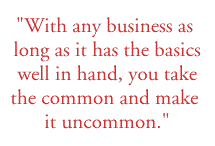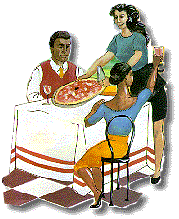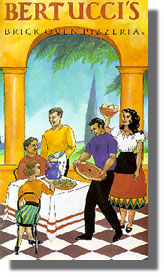Overview
This serial entrepreneur describes his success in building a national and publicly held Italian restaurant chain after pioneering the gourmet ice cream business.
Pizza and Ice Cream Phenomenon
Describing the characteristics of a successful entrepreneur often generate adjectives such as resourceful, innovative, tireless and visionary. In one way or another the individual that strove to develop a successful business possesses strong traits that complement the vision of their company in order to execute and ultimately succeed. Joey Crugnale of Bertucci’s Inc. is just such an individual when it has come to the development of his nationwide Italian restaurant chain. His success in opening upwards of eighty restaurants in states up and down the east coast and into Atlanta and Chicago can be attributed to his characteristics of commitment to the authentic preparation of high quality Italian food, and a passion for the retail business and working on a level eye to eye with the consumer.
Bertucci’s is by no means an ordinary restaurant chain that has been successful in setting up locations throughout a diverse geographic area. In June of 1991 Bertucci’s completed its IPO on the NASDAQ stock exchange with a flurry of anticipation and excitement from investors eager to capitalize on new and innovative business ventures. The stock was an strong performer when it opened to the public at $13 per share and shot up to over $34 in January of 1992 before splitting 3:2 the following March. From there this stock performed steadily as it ascended for the months to come to upwards of $25 in August of 1993. Bertucci’s has also outlived many of the competitors that sprang up attempting to copycat the restaurant’s successful formula of quality food and unique contemporary ambiance.
What’s even more intriguing is that this retail food business was not this entrepreneur’s first home-run in this industry. In the late 1970’s and early 1980’s Joey Crugnale took the reigns of a small and niche market ice cream store called Steve’s Ice Cream located in humble Somerville, Massachusetts. He took what the owner Steve Herrell considered as an ice cream fad in a local market that was on its last leg, and turned it into a national phenomenon as one of the original players in the premium ice cream business that includes other phenomenon organizations such as Vermont’s Ben & Jerry’s. Retail stores for Steve’s grew out to many diverse geographic areas, and this rich and gooey premium ice cream ultimately found its way into the heavier commercial supermarket industry. It was from this ice cream business that Bertucci’s was born, and quite unintentionally as you will discover.
So how does and Italian born native who was moved to the Italian North End of Boston, Massachusetts when he was five years old start two multi-million dollar retail food ventures and cause a splash on Wall Street? Read on to learn more about this restaurateur and how his love for working with customers face to face drove his desires to build successful ventures. Also learn how the rapid growth of a company can take its toll on an organization and how the road to growing revenues and expanding presence is not always without its bumps.
Steve’s Ice Cream – “Take the common and make it uncommon”
The Steve’s Ice Cream store had become a success prior to Joey Crugnale’s involvement with the company. Joey was running his own ice cream store nearby in Somerville, Massachusetts called Joey’s and observed the success that the Steve’s store was having. Steve’s was creating what became known as premium ice cream with heavy and rich flavors combined with mix-ins of a wide variety of ingredients including chocolate chunks, Health Bar crunch, and other non-traditional ingredients with ice cream. A trademark strategy of Joey’s that proved to be successful with both Steve’s and Bertucci’s is the capitalization on the unusual and non-traditional, “With any business as long as it has the basics well in hand, you take the common and make it uncommon.” The mix-ins with the ice cream and the making of the product in the window is what made Steve’s uncommon and thus new and very appealing to consumers. The success that Steve’s had already achieved with strong local business and a cult following combined into what Joey felt was a boon that was ready to explode. “There was no doubt in my mind that there was a niche that needed to be filled.”

Fortunately for Joey, the founder of Steve’s, Steve Herrell, felt this particular situation was a fad and was at the end of its life in 1976. Joey felt this unique food business was filling a need in the market that was going unexploited by other organizations, “There was no one else doing this on a big scale. Haagen-Dazs was relatively new and there was definitely a growing market for premium ice cream.” In 1976 Joey bought Steve’s from Steve Herrell for $80,000 and began to run the ice cream business along the same path that had already been established. What followed was the growth of the popularity of the ice cream product and the experience of visiting very colorful stores with hand-painted signs showing off unusual and wacky flavor names that are now common-place in this industry. Joey’s love for retail business led to aggressive expansion of new retail outlets nationwide, ultimately topping out at 26 outlets. As this business steadily grew in the late 1970’s Joey attributes the explosion of the premium ice cream industry in 1981 as the real spark that made Steve’s a national success. “Time Magazine did a story on it that legitimized it and featured Steve’s in the article. We were busy prior to that article but when it was published, it just strengthened the already packed to capacity business we had. It was a wild time!”
When asked how he reacted to the success of the business his response was one indicative of someone who is very confident in their business development capabilities, “You don’t go into business without expecting it to be successful. I would be surprised going into a business and not expecting it to be successful. With everything I do, it would be a major shock to me if it wasn’t successful.” Further conversation with Joey shows this not to be unfounded hubris based upon the first time success of an entrepreneur. Joey not only sites his observations and instincts as reasons for investing in a venture, but also methodical and meticulous research to support the pursuance of any opportunity, “I do my homework, I ask the right questions, and that in combination with my gut feel helps me make the decisions.” Marketing reports and demographic studies aside, it’s the instinctual part that is the biggest piece of the decision making process that Joey makes, “When it is all said and done, after all the work, the decision comes from the gut. I am a student of business and one of the companies I like to watch is Proctor & Gamble. They spend a lot of money on research and technology, and hire many MBA’s to speculate on new product opportunities and they fail 90% of the time. When you read about companies that succeed you see a pattern that it’s always the gut feel that played a big part. That’s important, a lot of people don’t have that.”
As the business continued to grow, the evolution of competitors and changing consumers preferences began to lead the prosperity of this product out of the retail outlet and into the larger consumer supermarket distribution. “The growth in the business was happening in the supermarkets not in retail stores. 80% to 90% of sales was now in supermarkets because it wasn’t as capital intense as retail stores were, and sales were less seasonal in supermarkets.” Joey knew he had to get into the supermarket aspects of the business to be able to keep up with the direction the industry was going, but his love for retail and the customer proved to be an impasse that would not take him in that direction, “It was a business that I was not interested in getting involved with. I had no experience in it. I know retail and I love retail. I love people. I had offers all along the way; Stop & Shop (a New England supermarket chain) offered to package it on a large scale but it never appealed to me. At the beginning of this trend we were making a lot of money and I didn’t have to do it.”
The influences that led to Joey selling out from Steve’s turned out to be not his decision alone. As with many entrepreneurs, the involvement of partners steers the course of the business in a direction that may be different from the founde’s vision because of the vested interest the other participants have. For this business situation, Joey was in a partnership with two other men that were ecstatic at the success of their premium ice cream venture and wanted to cash out while the company was still hot. “At that time I thought we hadn’t even started yet. I made them a deal that I would try to raise their asking price for their shares in the business in 90 days. If I couldn’t get it I’d sell out.” It turns out the asking price was $1 MM each and upon further reflection of the dollar amount, certain inevitable realities were realized that led Joey to capitulating with his partners, “I said, ‘Wait a minute, where am I going to get that kind of money? What if I get the $2 MM and the whole thing flops? They walk out with all that money and I get nothing.’ That killed me, that bothered me.” In 1983 Joey successfully sold Steve’s for $4.5 MM dollars creating a tremendous return for the eight years he ran that organization.
It might be considered a rare thing for an individual to be able to stick to what they love doing in the business venture they are pursuing, grow and become successful with it, and have the strength as the industry grows to turn down larger and more profitable offers to maintain the type of organization the founder wishes to have, “I knew who I was and what I liked to do, and I stick to that. It becomes a lifestyle. I liked walking into my stores and seeing my customers and trying new flavors as opposed to going to a plant. I don’t like that, it was a position I didn’t want.”
Bertucci’s Italian Restaurant – The restaurant next door

Joey’s foray into authentic Italian quisine had started prior to his departure from Steve’s. As his efforts were focused on making Steve’s as large and successful as possible, the idea that gave birth to his restaurant fortune came while trying to protect the integrity and quality of Steve’s. “The original Steve’s was located in a busy retail area in Somerville. Steve’s had grown to be very successful because even on rainy days we would have lines out the door. We didn’t have a season, it was like that all year long. (You’ll never see that again!) All of these other restaurants wanted to be near us to feed off of our business. I knew that a Chinese restaurant wanted to move in next door and I do not particularly like Chinese food or the odor that comes from their cooking. I didn’t want influences such as that affecting Steve’s so I decided to take over the space and put in my own restaurant.” Joey’s intention was not to make the new restaurant he opened a profit center, or even a commercial success. “I never intended it to be a profit maker because the space was so small and the table space was so limited. It was a way to keep other restaurants and businesses next to Steve’s out, a way for me to have some fun, and a place to bring my friends to drink wine and play boccie.”
It was not immediately that Joey embarked on growing Bertucci’s into a commercial success. Two years after he started the restaurant and departed from Steve’s, he took advice from certain individuals that convinced him to use his profits from the sale of Steve’s to invest in real estate. “They told me when you make some money you’re supposed to buy real estate to be safe.” It did not take long for this entrepreneur at heart to realize this lifestyle did not match what his personal goals were, “I fell asleep buying real estate. You go to a bank, you borrow money, you go to a contractor, you give some plan to build something…it’s boring.” It only took him two years to get in and out of real estate to search of the excitement he had achieved with Steve’s, and all this time he had hung on to Bertucci’s because he loved the concept. It was that concept he looked to to begin his next venture.
The location and the relaxed atmosphere of Bertucci’s was only part of the formula that ultimately grew the restaurant into the large chain that it is now. The other critical pieces were the authenticity of the food to be prepared and served, and the care that went into making the food as high a level a quality as possible. Coming from Italy, Joey had grown up surrounded by food and the passion of authentic preparation by his mother and grandmother. “My mother was a great cook, it was absolute quality and home-made. I grew up seeing this attention and detail while living in the North End of Boston. I noticed the difference of such care when we moved away from the North End into a suburb of Boston where there weren’t a lot of Italians.” Here is where his understanding of high quality and authenticity being brought to people who do not expect it can result in high level of acceptance by the customers.
While on a visit to Italy, Joey visited the house he was born in an discovered a small brick edifice sitting in the back yard. He asked his relatives what the structure was and they told him it was what they used to cook a lot of their food in. It was a brick oven and once he had noticed it in this backyard, he noticed it in many backyards throughout Italy. This oven became the cornerstone for the creation of authentic and high quality Italian food that made Bertucci’s so successful and accepted by consumers. He brought the concept of the oven back into Bertucci’s which culminated into his formula for this high quality Italian restaurant. “I saw that we were able to make a great pizza from the restaurant. I did market studies and determined that nobody was doing quality pizza back then, just pizza houses and full Italian restaurants that had pizza as a selection on the menu.” This opportunity all goes back to the common philosophy he employed with Steve’s and could now continue to utilize and benefit from, take something that is common and make it uncommon. “Nobody was doing really high quality pizza. I saw there was a niche.”
With this foundation in place, the planning and execution began to fine tune the menu, add more dishes such as pastas and desserts, and grow from the o riginal location in Somerville. “This all started while Steve’s was the driver for the income. It worked together with my efforts in establishing the right lifestyle and the right type of business.”

